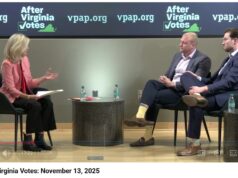( – promoted by lowkell)
 Part 2 of my series (leading up to the next DPVA meeting) examining how DPVA can be the best state party possible.
Part 2 of my series (leading up to the next DPVA meeting) examining how DPVA can be the best state party possible.
Dave Leichtman is the DPVA Vice-chair for Technology and Communications
Last week, we delved into the financial side of how we can make our party the best it can be (Read: “A Better DPVA in Depth – Part 1: Money”). Since then, a lot has happened! It’s no secret that I’m not comfortable with the Governor’s advancement of Mayor Jones as his pick to be Chair. But I’m going to avoid that topic here and focus on moving forward after March 15th. Whoever emerges as Chair, Mayor Jones or otherwise, has a lot of work to do and is going to need all of the help he or she can get.
Somebody once told me that they were seriously disappointed in the Party over the primary results from June 2013 when both candidates of color (Justin Fairfax and Aneesh Chopra) lost. They said that we needed to instill racial diversity in our party and candidates. I agree, but I don’t agree on the method or the outcome. Primaries are democratic, and it’s the way we should pick our nominees. Tinkering with the will of the people may produce the results you desire, but it doesn’t always lead to the strongest outcomes. What then is the solution to promoting racial and gender diversity in statewide candidates? Start at the bottom: local candidates! If we have quality, diverse candidates for local offices, then the most qualified ones will work their way up, plain and simple.
So let’s talk about how we can recruit the best candidates to run locally and how we can foster and develop talent.
1) The will to coordinate. Seems silly to say, but currently, the effort to recruit candidates is an incredibly fragmented task. The CD Chairs are often left to their own devices for finding Congressional candidates; the House and Senate Caucuses are left to recruit for their offices; and for local offices, a slapdash combo or the Party and local committees comes into play, but only sometimes – often local candidates simply self-select where the party isn’t strong. DPVA needs to grab hold of the reins and lead the effort. Until we have a overarching system and method for identifying and approaching candidates, this effort will always be haphazard.
2) The tech and the process to coordinate. This one is easily doable, it just involves a coordinated push on #1. DPVA could easily maintain an online platform like Salesforce (or some other CRM) to manage recruiting and goals – just like a well run sales-oriented business. Leads becomes qualified leads, qualified leads become opportunities, closed opportunities become candidates. See how that goes? The trick of this is giving access to all interested parties in a secure and siloed way – completely possible using commercially available tools designed specifically for this. The process need only be outlined and the tools deployed.
3) Investing in our committees. As a corollary to #2, the best place to recruit local talent is from within the local committees. But those committees need training and instruction on how to best assist in that effort. Giving the tools to help, training them on how to do so, and executing on a plan is paramount to stepping up our local recruiting game.
4) Cultivating recruits. One criticism I regularly hear from losing candidates is that once they lose, nobody follows up with them. We need a coordinated effort to foster quality candidates, even after they lose. Because today’s losers can be tomorrow’s winners, even in a red district. It just takes time to build up public name ID and to build a base of support (both Field and $). Good candidates need to be encouraged to run again, not ignored.
5) Making it easier to run. Candidates are often given impossibly high bars to surmount in order to run for any serious office. Often, to run for Delegate, it requires raising enough money to conduct a poll. Fine for weeding out perennial runners and whacktivists, but a difficult hump for serious candidates in rural and red areas to get over. Tracking and more methodical recruiting and coordinating can help eliminate the noise while allowing caucuses and committees to lower their barriers to entry. The Party can play a big role here with “ready to go” resources for candidates – info, tech, training, and other resources on-demand for good prospective candidates who might need it.
That’s it for now. Stay tuned for Part 3, tentatively about what role is best for the Party to play and how DPVA can remain relevant in the age of modern campaigning.
In the meantime, discuss!













![[UPDATED with Jim Ryan’s Letter] In Response to Youngkin’s “Sad, Whiny” Letter to Spanberger About UVA, VA Senate Majority Leader Surovell Says He’s “truly embarrassed for Gov Youngkin…After 4 yrs he has no understanding of basic VA govt structure”](https://bluevirginia.us/wp-content/uploads/2025/11/youngkinspanuva3-100x75.jpg)